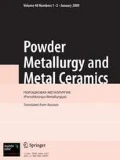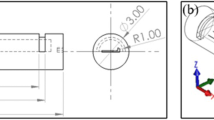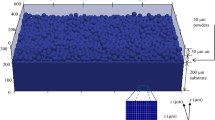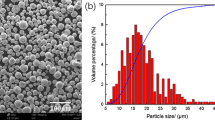The characteristics of single-track melt pools, such as size, shape, and stability, formed by the heatresistant Inconel 718 nickel alloy powder subjected to selective laser melting (SLM) were studied. The objective was to determine the range of optimal SLM parameters to provide a stable track with a depth of two to three layers. Single tracks were built using various combinations of process parameters: laser power from 50 to 400 W with a step of 30 W and scanning speed from 450 to 1000 mm/sec with a step of 50 mm/sec (144 modes in total). An Axiovert 200M MAT light microscope (Carl Zeiss) was employed to examine the cross sections of single tracks and evaluate the geometrical parameters of the melt pools. Features pertaining to the effect of the scanning speed and laser power on single-track depth and width and their ratio were experimentally studied. An unstable track formed at low power (P = 50 W) and low scanning speed (V = 450–500 mm/sec), while no track appeared at all at higher speeds. A stable track formed at power P = 80–200 W at low speeds (V = 500–900 mm/sec) and became unstable and intermittent when speed increased to V = 1000 mm/sec. With higher laser power (P = 230–400 W) and low process speeds, a continuous track formed but had an increased variable width, being indicative of a deviation from the stable track formation conditions. It was first established that the intensity of the scanning speed effect (450–1000 mm/sec) on the single track depth varies by more than 2.5 times depending on the laser power (50–400 W). The process parameters that would ensure the formation of an optimal single track in terms of geometric parameters were determined.









Similar content being viewed by others
References
A.R.C. Sharman, A. Amarasinghe, and K. Ridgway, “Tool life and surface integrity aspects when drilling and hole making in Inconel 718,” J. Mater. Process Technol., 200, 424–432 (2008).
A.K. Parida and K. Maity, “Comparison the machinability of Inconel 718, Inconel 625 and Monel 400 in hot turning operation,” Eng. Sci. Technol. Int. J., 21, 364–370 (2018).
N. Narutaki, Y. Yamane, K. Hayashi, and T. Kitagawa, “High-speed machining of Inconel 718 with ceramic tools,” CIRP Annals., 42, 103–106 (1993).
Y.M. Arisoy, L.E. Criales, T. Özel, and B. Lane, “Influence of scan strategy and process parameters on microstructure and its optimization in additively manufactured nickel alloy 625 via laser powder bed fusion,” Int. J. Adv. Manuf. Technol., 90, 1393–1417 (2017).
L.E. Criales, Y.M. Arisoy, B. Lane, and T. Özel, “Laser powder bed fusion of nickel alloy 625: Experimental investigations of effects of process parameters on melt pool size and shape with spatter analysis,” Int. J. Mach. Tools Manuf., 121, 22–36 (2017).
X. Wang, X. Gong, and K. Chou, “Review on powder-bed laser additive manufacturing of Inconel 718 parts,” Proc. Inst. Mech. Eng. B J. Eng. Manuf., 231, 1890–1903 (2017).
C.B. Williams, F. Mistree, and D.W. Rosen, “Towards the design of a layerbased additive manufacturing process for the realization of metal parts of designed mesostructured,” in: Proc. 16th Solid Freeform Fabrication Symposium (2005), p. 217–230.
Concept Laser GmbH [electronic resource], Access: https://www.concept-laser.de/technologie.html.
L.-E. Loong, C.-K. Chua, W.-Y. Yeong, J. Song, M. Mapar, S.L. Sing, Zh.-H. Liu, and D.-Q. Zhang, “Numerical investigation and an effective modelling on the Selective Laser Melting (SLM) process with aluminium alloy 6061,” Int. J. Heat Mass. Transf., 80, 288–300 (2015).
K. Kempen, L. Thijs, E. Yasa, M. Badrossamay, and J.-P. Kruth, “Process optimization and microstructural analysis for selective laser melting of AlSi10Mg,” in: Solid Freeform Fabrication Symposium (2011), pp. 484–495.
C. Kamath, B. Eldasher, G.F. Gallegos, W. King, and A. Sisto, “Density of additively-manufactured, 316L SS parts using laser powder-bed fusion at powers up to 400 W,” Int. J. Adv. Manuf. Technol., 74, 65–78 (2014).
Q. Jia and D. Gu, “Selective laser melting additive manufacturing of Inconel 718 superalloy parts: densification, microstructure and properties,” J. Alloys Compd., 585, 713–721 (2014).
B. Song, S. Dong, H. Liao, C. Coddet, “Process parameter selection for selective laser melting of Ti6Al4V based on temperature distribution simulation and experimental sintering,” Int. J. Adv. Manuf. Technol., 61, 967–974 (2012).
J.J.S. Dilip, S. Zhang, C. Teng, K. Zeng, C. Robinson, D. Pal, and B. Stucker, “Influence of processing parameters on the evolution of melt pool, porosity, and microstructures in Ti–6Al–4V alloy parts fabricated by selective laser melting,” Prog. Additive Manuf., 2, 157–167 (2017).
H. Gu, H. Gong, D. Pal, H. K. Rafi, T. Starr, and B. Stucker, “Influences of energy density on porosity and microstructure of selective laser melted 17-4PH stainless steel,” in: Solid Freeform Fabrication Symposium (2013), p. 474–489.
J. Yang, J. Han, H. Yu, J. Yin, M. Gao, Z. Wang, X. Zeng, “Role of molten pool mode on formability, microstructure and mechanical properties of selective laser melted Ti–6Al–4V alloy,” Mater. Des., 110, 558–570 (2016).
C. Kamath, “Data mining and statistical inference in selective laser melting,” Int. J. Adv. Manuf. Technol., 86, 1659–1677 (2016).
W.J. Sames, F. List, S. Pannala, F.A. List, and R.R. Dehoff, “The metallurgy and processing science of metal additive manufacturing,” Int. Mater. Rev., 61, 315–360 (2016).
K.N. Amato, S.M. Gaytan, L. E. Murr, E. Martinez, P.W. Shindo, J. Hernandez, S. Collins, and F. Medina, “Microstructures and mechanical behavior of Inconel 718 fabricated by selective laser melting,” Acta Mater., 60, 2229–2239 (2012).
M. Pröbstle, S. Neumeier, J. Hopfenmüller, L.P. Freund, T. Niendorf, D. Schwarze, and M. Göken, “Superior creep strength of a nickel-based superalloy produced by selective laser melting,” Mater. Sci. Eng. A., 674, 299–307 (2016).
G.E. Bean, D.B. Witkin, T.D. McLouth, and R.J. Zaldivar, “The effect of laser focus and process parameters on microstructure and mechanical properties of SLM Inconel 718,” Int. Soc. Optics Photonics., 10523, 105230Y (2018).
J.-P. Choi, G.-H. Shin, S. Yang, D.-Y. Yang, J.-S. Lee, M. Brochu, and J.-H. Yuad, “Densification and microstructural investigation of Inconel 718 parts fabricated by selective laser melting,” Powder Technol., 310, 60–66 (2017).
Haijun Gong, Hengfeng Gu, Kai Zeng, J.J.S. Dilip, Deepankar Pal, and Brent Stucker, “Melt pool characterization for selective laser melting of Ti–6Al–4V pre-alloyed powder,” in: Solid Freeform Fabrication Symposium (2014), p. 256–267.
Author information
Authors and Affiliations
Corresponding author
Additional information
Translated from Poroshkova Metallurgiya, Vol. 59, Nos. 9–10 (535), pp. 137–147, 2020.
Rights and permissions
About this article
Cite this article
Adjamsky, S., Tkachev, Y.V. & Kononenko, G. Effect of Selective Laser Melting Parameters on the Melt Pool Formed by Single Tracks of the Heat-Resistant Inconel 718 Nickel Alloy. Powder Metall Met Ceram 59, 592–600 (2021). https://doi.org/10.1007/s11106-021-00183-8
Received:
Published:
Issue Date:
DOI: https://doi.org/10.1007/s11106-021-00183-8




